Study on the Evolution of Tailings Dam Break Disaster under Complex Environment
Abstract
:1. Introduction
2. Overview of the Proposed Tailings Pond
3. Establishment of Tailings Dam Model
3.1. Model Test Principles
- (1)
- Similar conditions for tailings settlement
- (2)
- Similar conditions of water flow and sand retention
- (3)
- Similar conditions of scouring and warping deformation
3.2. Model Construction
3.3. Comparison and Selection of Terrain Model Construction Methods
- (1)
- Electronic topographic map processing: CAD topographic maps are processed and reduced to a scale of 150. The contour lines are selected for measurement and setting out based on the size of the filling block.
- (2)
- Laying concrete aerated blocks involves laying the blocks along the contour line with the lowest elevation, starting from the valley and extending to the model boundary. Once the first layer is in place, subsequent layers are lofted on top of each other along the contour line until the highest layer is reached.
- (3)
- Mountain shaping: Concrete is utilized to create a seamless transition between the stepped terrain resulting from the installation of aerated blocks.
- (4)
- Cement mortar plastering is the final step in terrain treatment, which must be carried out to meet the requirements of experimental roughness.
- (5)
- Iconic landmarks are used for positioning, including roads, rivers, small bridges, farmland, and houses.
3.4. Infiltration Line Control and Measurement System
3.5. Model Size Affects the Control Principle
- (1)
- The physical and mechanical properties are stable and will not have a big impact when the atmospheric temperature and humidity change.
- (2)
- The tailings dam body will not have large shrinkage, expansion, and other deformation after forming.
- (3)
- The permeability, deformation, and strength properties are similar to those of the tailings materials.
- (4)
- Suitable bulk density is met.
- (5)
- The sudden collapse displacement of the prototype and the movement characteristics of debris flow are met.
4. Determination of Physical and Mechanical Indicators of Model Sand and Prototype Sand
4.1. Physical and Mechanical Properties Indicators of Prototype Sand
4.2. Model Sand Selection
4.3. Preliminary Tests
- (1)
- First and Second Preparatory Tests
- (2)
- Third and fourth wetting line control tests in the preparation stage.
4.4. Summary of Preliminary Tests
- (1)
- The higher the compaction degree of the accumulated dam, the slower the process of dam failure and the smaller the volume of collapse. Additionally, it was observed that hydraulic infiltration achieved a greater level of compactness (ρd = 0.87 g/cm3) compared to artificial rolling (ρd = 0.74 g/cm3). Therefore, during formal testing, it is imperative to ensure an appropriate infiltration time for optimal results.
- (2)
- The size gradation of model sand particles should be moderate, as it greatly affects the post-failure collapse mode of a dam body. An excess of large particles results in higher porosity and potential for piping phenomena, while an excess of small particles increases cohesion and viscosity, resulting in narrower collapse widths and potential for compaction phenomena.
- (3)
- The saturation line is a critical factor in maintaining the stability of tailings reservoirs, as it determines the degree of saturation within the reservoir and greatly impacts outburst behavior during dam break events. During testing, it is important to control the head of the saturation line to ensure that model results accurately reflect those observed in real-world prototypes.
5. Physical Model Dam Break Test
5.1. Introduction to Test Conditions
5.2. Dam Failure Process
5.3. Downstream Evolution Process of Water-Sand Flow
- (1)
- The affected process of Shangdi Village
- (2)
- The affected process of Shizhou Village
5.4. Post-Collapse Inundation Area
5.5. Water Level Process Line
5.6. Dam Break Flow Field
6. Discussion
7. Limitations
8. Conclusions
- (1)
- The particle size distribution of model sand should be moderate, and the composition of particle gradation significantly affects the post-failure deformation behavior of the dam body. When the sand body contains more coarse particles, its porosity increases, which may lead to a pipe surge phenomenon. When there are too many small particles, the cohesion increases, and the collapse width is relatively small due to viscosity, making it easy to produce compaction phenomena. The level of the wetting line determines the saturation degree of tailings in the reservoir and has a significant impact on outburst form during dam break. Therefore, controlling the head of the wetting line during testing is crucial to ensure that it matches that of the prototype.
- (2)
- The breach was situated at the mid-point of the dam crest, and the volume of water that infiltrated into the reservoir during its occurrence was 0.313 m3. Based on flow ratio analysis, this amount equated to 1.78 times that of a 1000-year flood event and 1.19 times that of a PMF flood. The entire process of dam failure, which lasted for 27 min and 36 s, took approximately 4.1 h in the prototype. The plane area of the silting zone measured 24.8 m2, equivalent to about 0.558 km2 in the prototype, while the volume of tailings collapse was estimated at 3.848 m3 (approximately 1.3 × 107 m3 in the prototype), accounting for roughly 14% of total reservoir capacity. The rupture attained a maximum extent of approximately 1.5 m and a depth of roughly 1.4 m, and the prototype measured 225 m in width by 210 m in depth.
- (3)
- The time taken for the dam-broken water to reach Shangdi village was 1 min and 49 s, which was reduced from the prototype’s 22 min. The inundation of houses in Shangdi village by the dam break sand flow occurred within 2 min and 6 s, compared to the prototype’s 26 min. Since then, the sand flow resulting from the dam break continued to intensify, impacting Shangdi village for a duration of 5 min and 13 s (equivalent to 1.1 h in prototype time). It took approximately 3 min for the water to reach Zhou village (31 min in prototype time), after which it flowed only along the river and low-lying areas with a gradual rise in water level. After 12 min and 20 s, the houses in Shizhou Village with an elevation below 457 m were subject to backwater impact. At the time of 15 min and 34 s, equivalent to a prototype duration of 3.2 h, houses in Shizhou Village with an elevation lower than 461 m were affected by backwater.
- (4)
- From the analysis of water level elevation, it is evident that both Shangdi village and houses below 461 m in Shizhou Village are affected by flooding and sand flow. From the analysis of the surface flow field, it can be observed that the village located upstream of the dam exhibited the highest flow velocity. The terrain surrounding the dam has effectively obstructed and dissipated multiple instances of sand flow from a potential dam break, resulting in significant energy release and reduction in debris flow velocity. When the debris flow resulting from the dam break passed through the Shizhou village area, a majority of the fluid was diverted towards low-lying farmland downstream of the village. The impact on Shizhou village was limited to backwater effects caused by broken dam flow and the gradual siltation of tailings.
Author Contributions
Funding
Institutional Review Board Statement
Informed Consent Statement
Data Availability Statement
Conflicts of Interest
References
- Yekti, M.I.; Adityananta, I.K.E.B.; Pariartha, I.P.G.S. The Tamblang Dam Break Analysis Using HEC-RAS 5.0.7 and PenRis Hazard Classification in Indonesia. Arab. J. Geosci. 2023, 16, 365. [Google Scholar] [CrossRef]
- Chen, M.; Jing, X.; Xie, D.; Li, X.; Zhang, Y.; Liu, X. Prediction Model Investigations of the Reinforced Fine-Grained Tailings Dam Overtopping Failure. Front. Earth Sci. 2023, 10, 1075588. [Google Scholar] [CrossRef]
- Dumergue, L.E.; Abadie, S. Numerical Study of the Wave Impacts Generated in a Wet Dam Break. J. Fluids Struct. 2022, 114, 103716. [Google Scholar] [CrossRef]
- Mattas, C.; Karpouzos, D.; Georgiou, P.; Tsapanos, T. Two-Dimensional Modelling for Dam Break Analysis and Flood Hazard Mapping: A Case Study of Papadia Dam, Northern Greece. Water 2023, 15, 994. [Google Scholar] [CrossRef]
- Aleixo, R.; Ozeren, Y.; Altinakar, M. Tailings Dam-Break Flow Analysis by Means of a Combined PIV-PTV Tool. In Proceedings of the Conference on Fluvial Hydraulics, Lausanne, Switzerland, 3–5 September 2014. [Google Scholar]
- Schaefer, M.; Bugnion, L. Velocity Profile Variations in Granular Flows with Changing Boundary Conditions: Insights from Experiments. Phys. Fluids 2013, 25, 063303. [Google Scholar] [CrossRef]
- Sánchez-Peralta, J.A.; Beltrán-Rodríguez, L.N.; Trujillo-Vela, M.G.; Larrahondo, J.M. Flows of Liquefied Filtered Tailings: Laboratory-Scale Physical and Numerical Modeling. Int. J. Civ. Eng. 2020, 18, 393–404. [Google Scholar] [CrossRef]
- Gao, J.; Fourie, A. Using the Flume Test for Yield Stress Measurement of Thickened Tailings. Miner. Eng. 2015, 81, 116–127. [Google Scholar] [CrossRef]
- Le Nguyen, Q.T.; Nguyen, V.D.; Coorevits, P. Scouring of a Granular Bed by Dam Break: Experimental Study and Numerical Simulation by a VOF-LPT Coupling. Int. J. Sediment Res. 2023, 38, 432–445. [Google Scholar] [CrossRef]
- Hamza, M.H.; Saegh, A.M. Flash Flood Risk Assessment Due to a Possible Dam Break in Urban Arid Environment, the New Um Al-Khair Dam Case Study, Jeddah, Saudi Arabia. Sustainability 2023, 15, 1074. [Google Scholar] [CrossRef]
- Özgenç Aksoy, A.; Doğan, M.; Oğuzhan Güven, S.; Tanır, G.; Güney, M.Ş. Experimental and Numerical Investigation of the Flood Waves Due to Partial Dam Break. Iran. J. Sci. Technol. Trans. Civ. Eng. 2022, 46, 4689–4704. [Google Scholar] [CrossRef]
- Yu, D.; Tang, L.; Ye, F.; Chen, C. A Virtual Geographic Environment for Dynamic Simulation and Analysis of Tailings Dam Failure. Int. J. Digit. Earth 2021, 14, 1194–1212. [Google Scholar] [CrossRef]
- Chen, C.; Ma, B. Safety Assessment of Dam Failure of Tailings Pond Based on Variable Weight Method: A Case Study in China. Min. Metall. Explor. 2022, 39, 2401–2413. [Google Scholar] [CrossRef]
- Ma, J.; Guan, J.; Duan, J.; Huang, L.; Liang, Y. Stability Analysis on Tunnels with Karst Caves Using the Distinct Lattice Spring Model. Undergr. Space 2021, 6, 469–481. [Google Scholar] [CrossRef]
- Ma, J.; Guan, J.; Gui, Y.; Huang, L. Anisotropic Bounding Surface Plasticity Model for Porous Media. Int. J. Geomech. 2021, 21, 04021033. [Google Scholar] [CrossRef]
- Ma, J.; Chen, J.; Chen, W.; Huang, L. A Coupled Thermal-Elastic-Plastic-Damage Model for Concrete Subjected to Dynamic Loading. Int. J. Plast. 2022, 153, 103279. [Google Scholar] [CrossRef]
- Melo, M.; Eleutério, J. Probabilistic Analysis of Floods from Tailings Dam Failures: A Method to Analyze the Impact of Rheological Parameters on the HEC-RAS Bingham and Herschel-Bulkley Models. Water 2023, 15, 2866. [Google Scholar] [CrossRef]
- Lyu, Z.; Chai, J.; Xu, Z.; Qin, Y.; Cao, J. A Comprehensive Review on Reasons for Tailings Dam Failures Based on Case History. Adv. Civ. Eng. 2019, 2019, 4159306. [Google Scholar] [CrossRef]
- Kean, J.W.; McCoy, S.W.; Tucker, G.E.; Staley, D.M.; Coe, J.A. Runoff-Generated Debris Flows: Observations and Modeling of Surge Initiation, Magnitude, and Frequency. J. Geophys. Res. Earth Surf. 2013, 118, 2190–2207. [Google Scholar] [CrossRef]
- Chen, H.-X.; Li, J.; Feng, S.-J.; Gao, H.-Y.; Zhang, D.-M. Simulation of Interactions between Debris Flow and Check Dams on Three-Dimensional Terrain. Eng. Geol. 2019, 251, 48–62. [Google Scholar] [CrossRef]
- Konzuk, J.S.; Kueper, B.H. Evaluation of Cubic Law Based Models Describing Single-Phase Flow through a Rough-Walled Fracture. Water Resour. Res. 2004, 40, 178. [Google Scholar] [CrossRef]
- Christen, M.; Kowalski, J.; Bartelt, P. RAMMS: Numerical Simulation of Dense Snow Avalanches in Three-Dimensional Terrain. Cold Reg. Sci. Technol. 2010, 63, 1–14. [Google Scholar] [CrossRef]
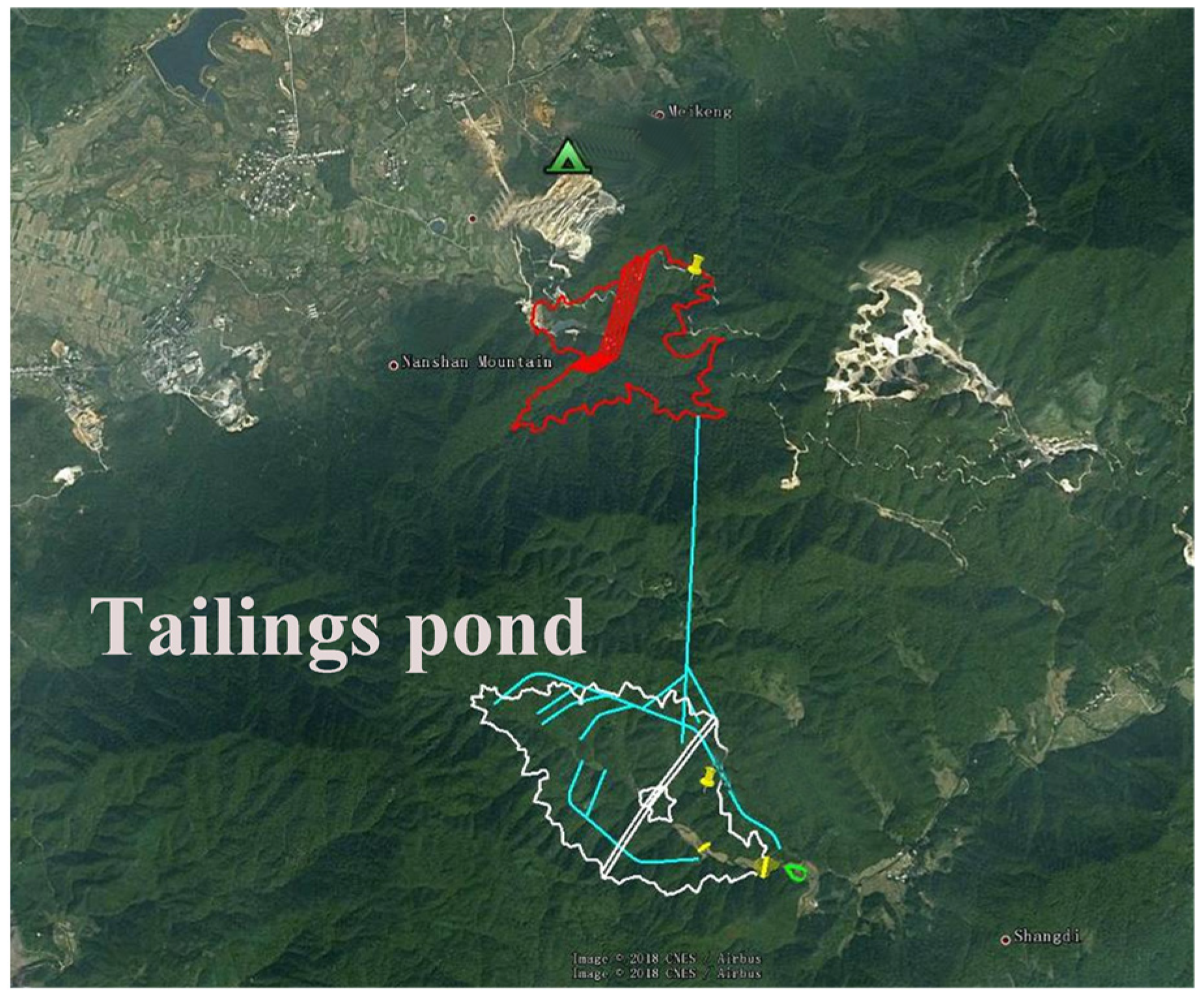

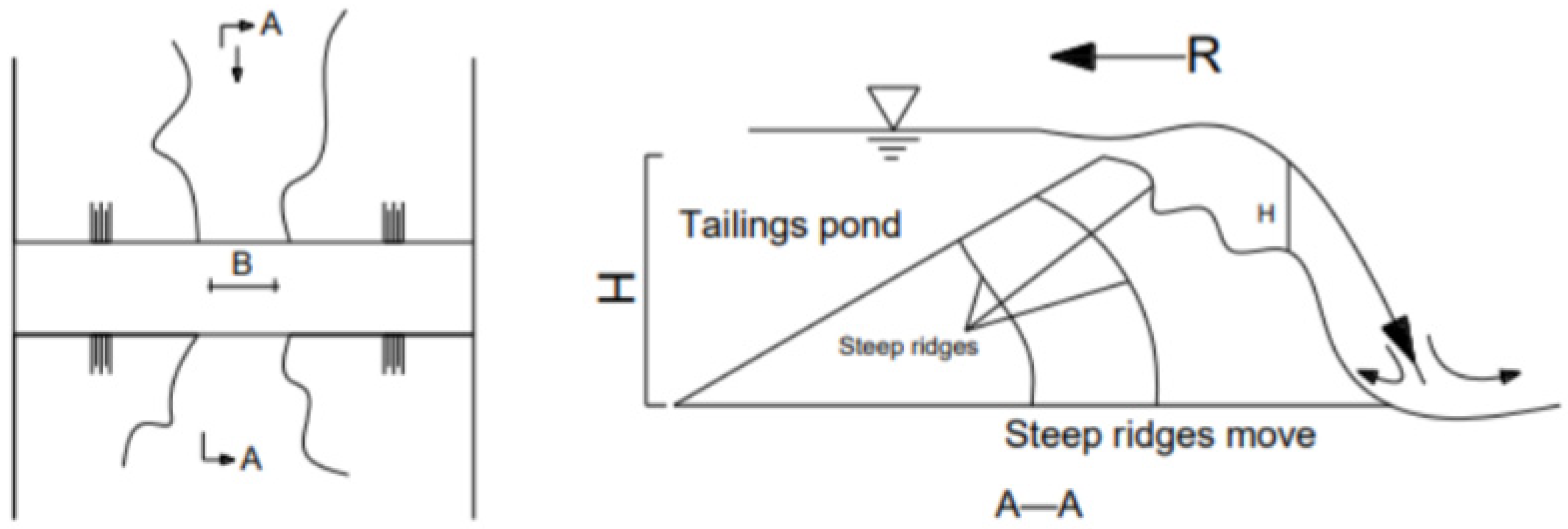
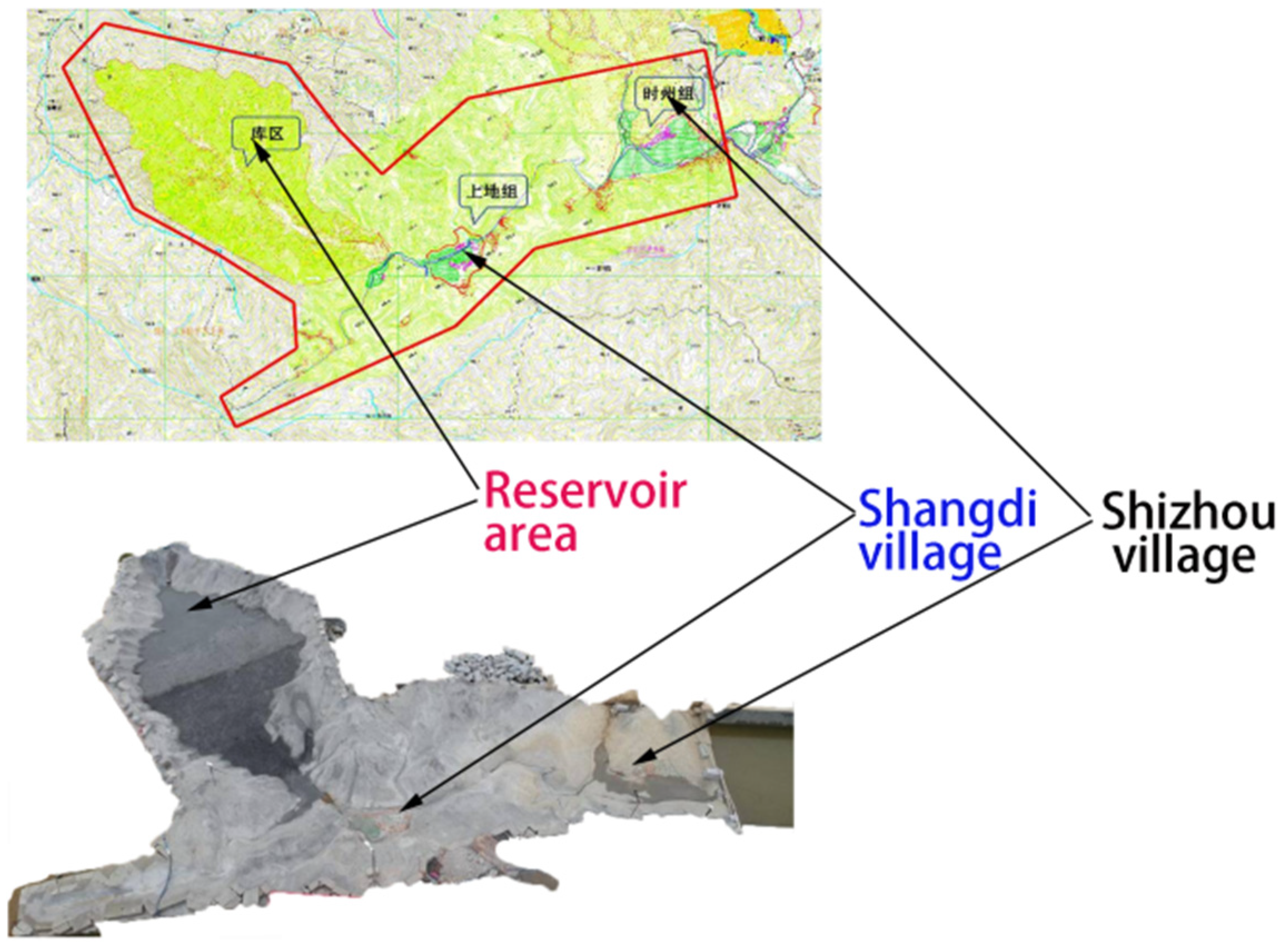


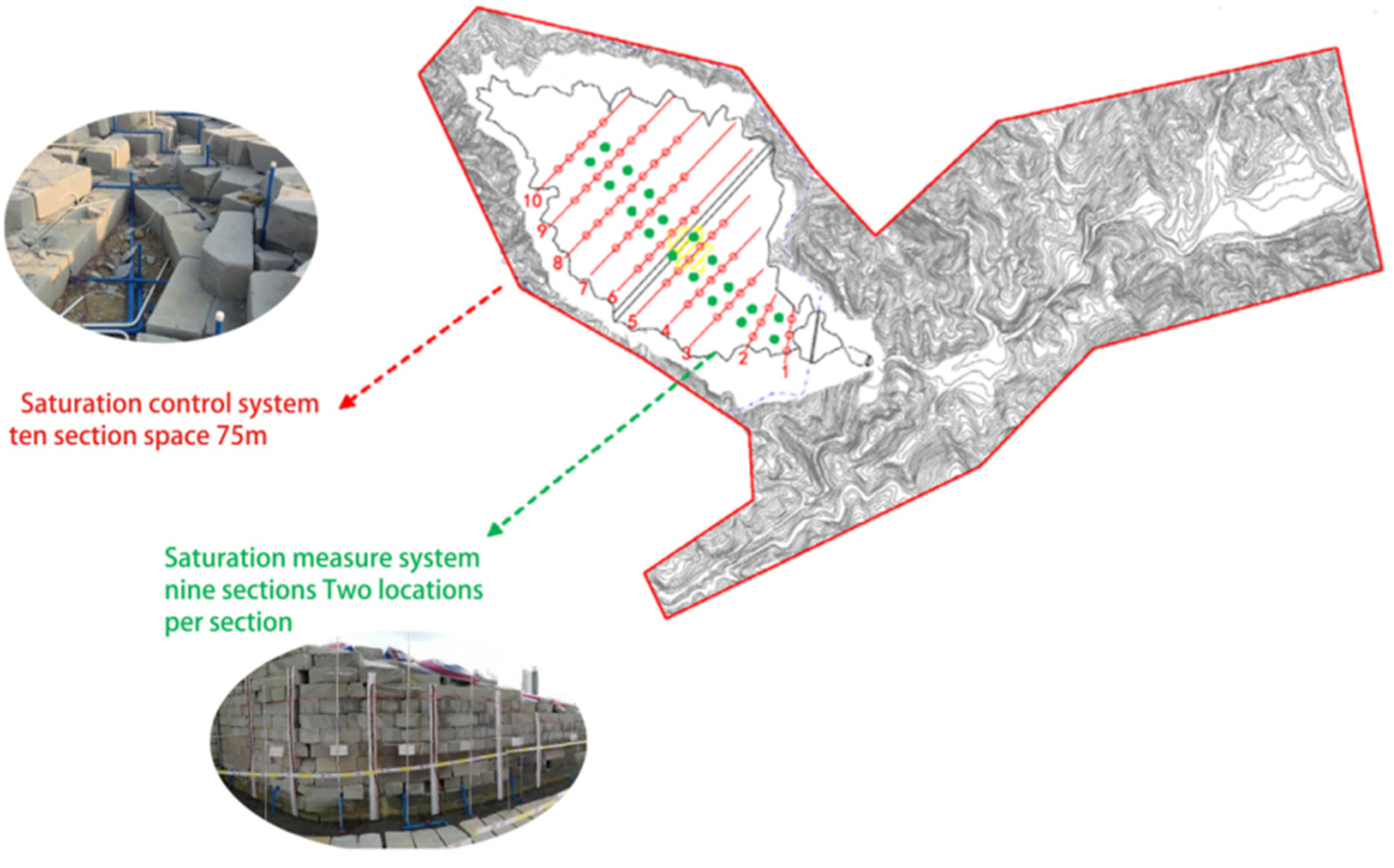
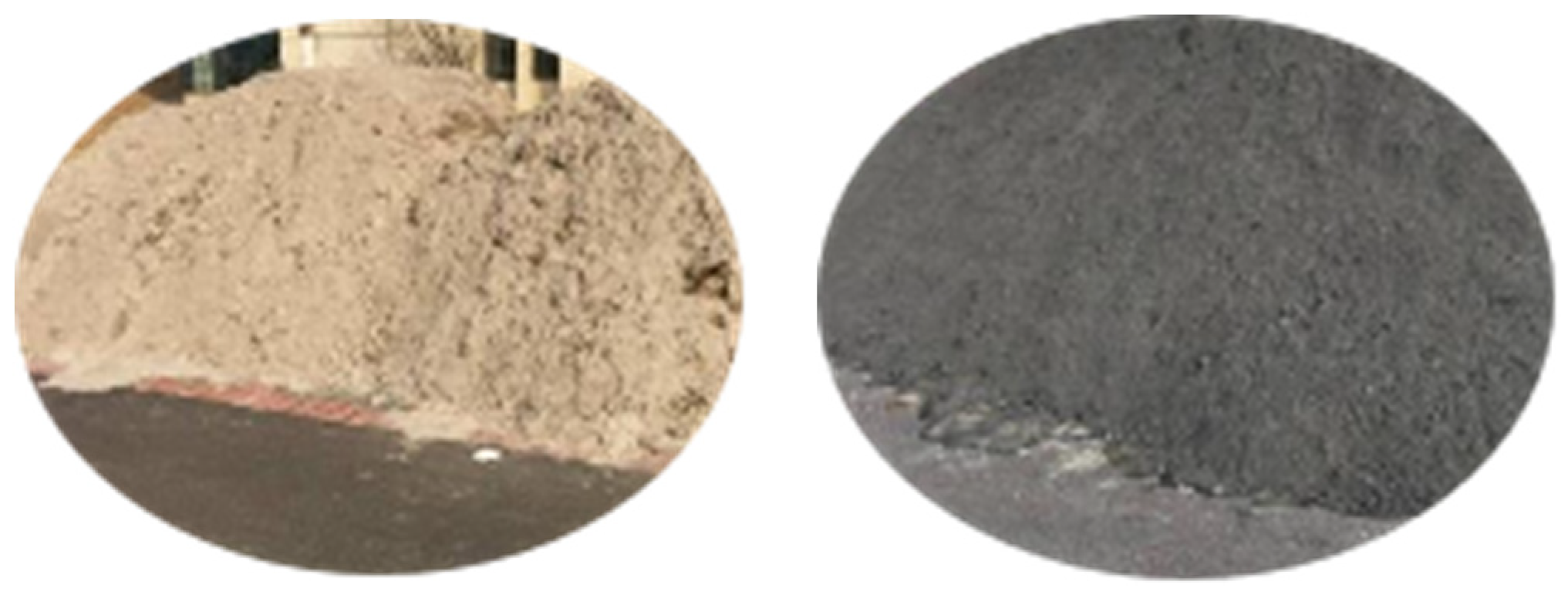
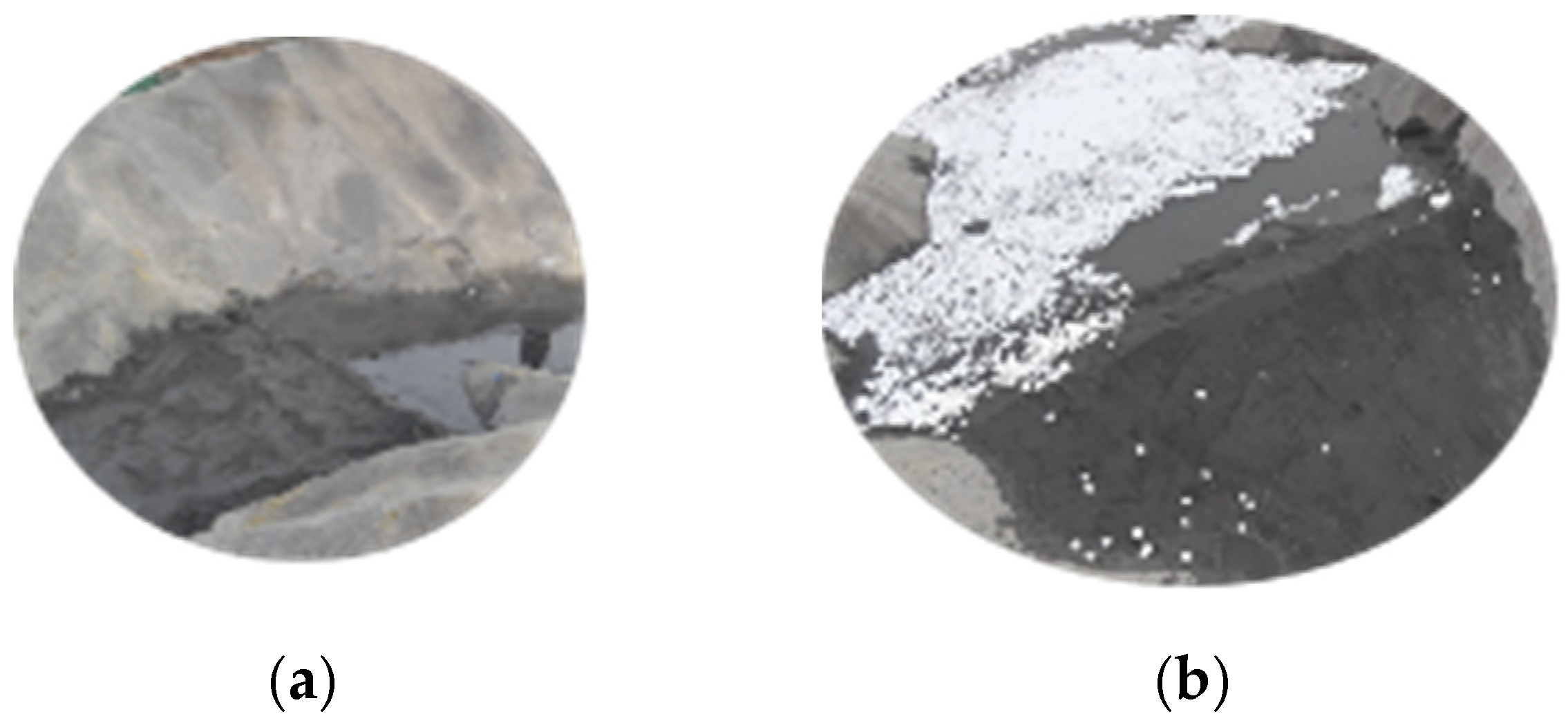
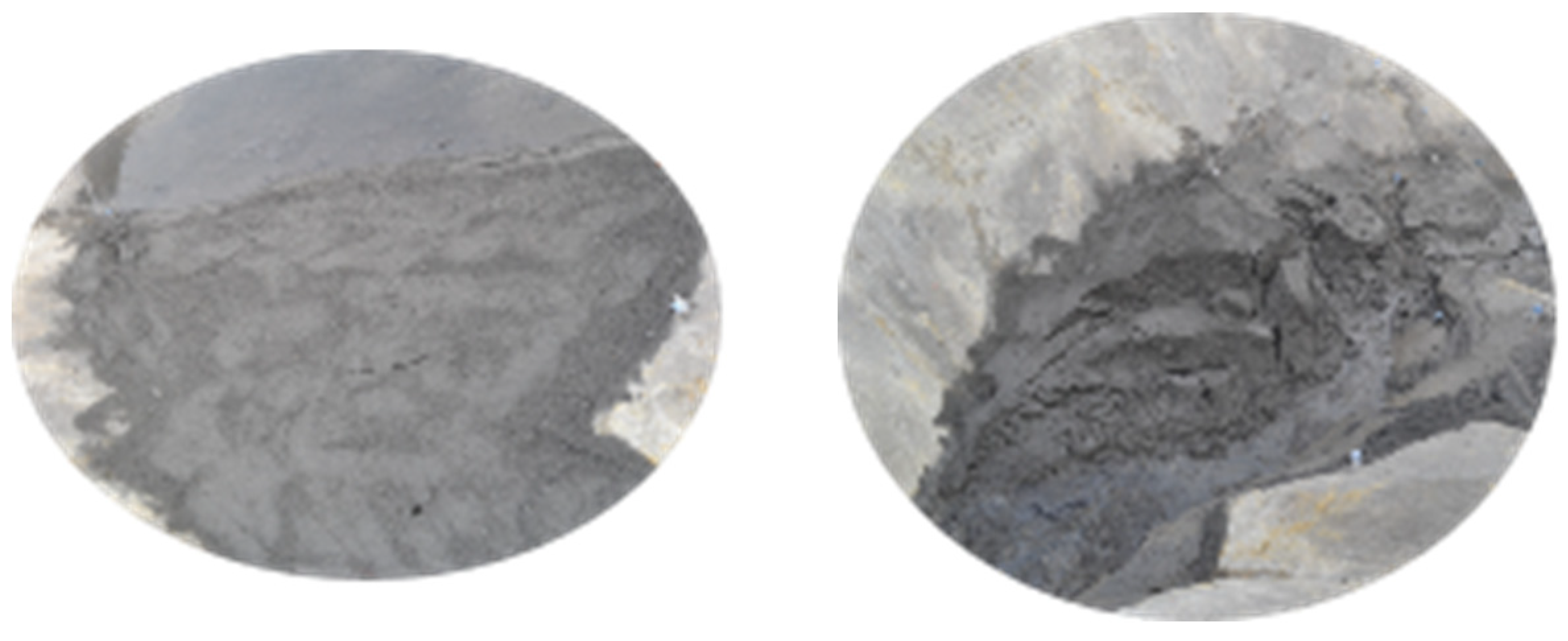

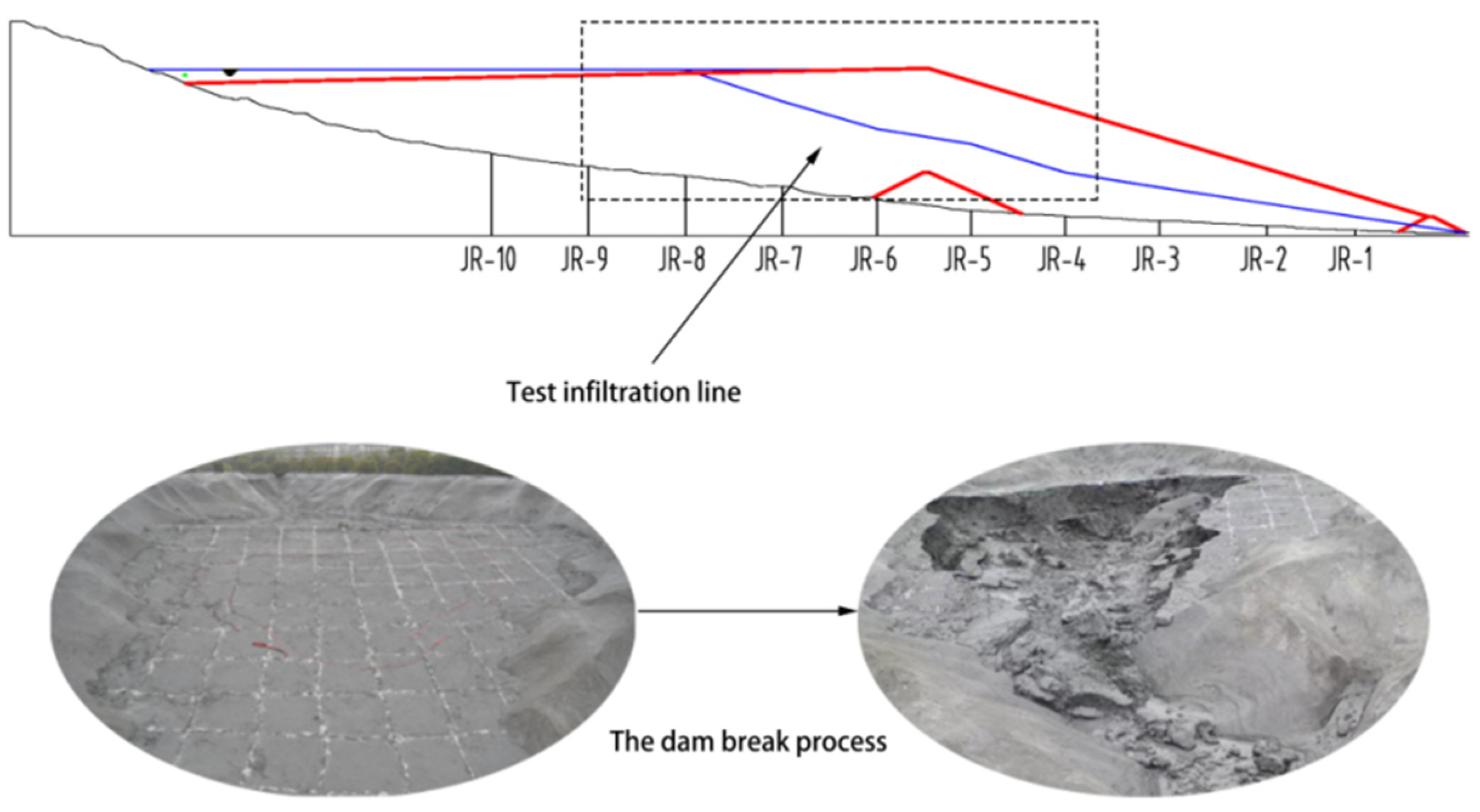

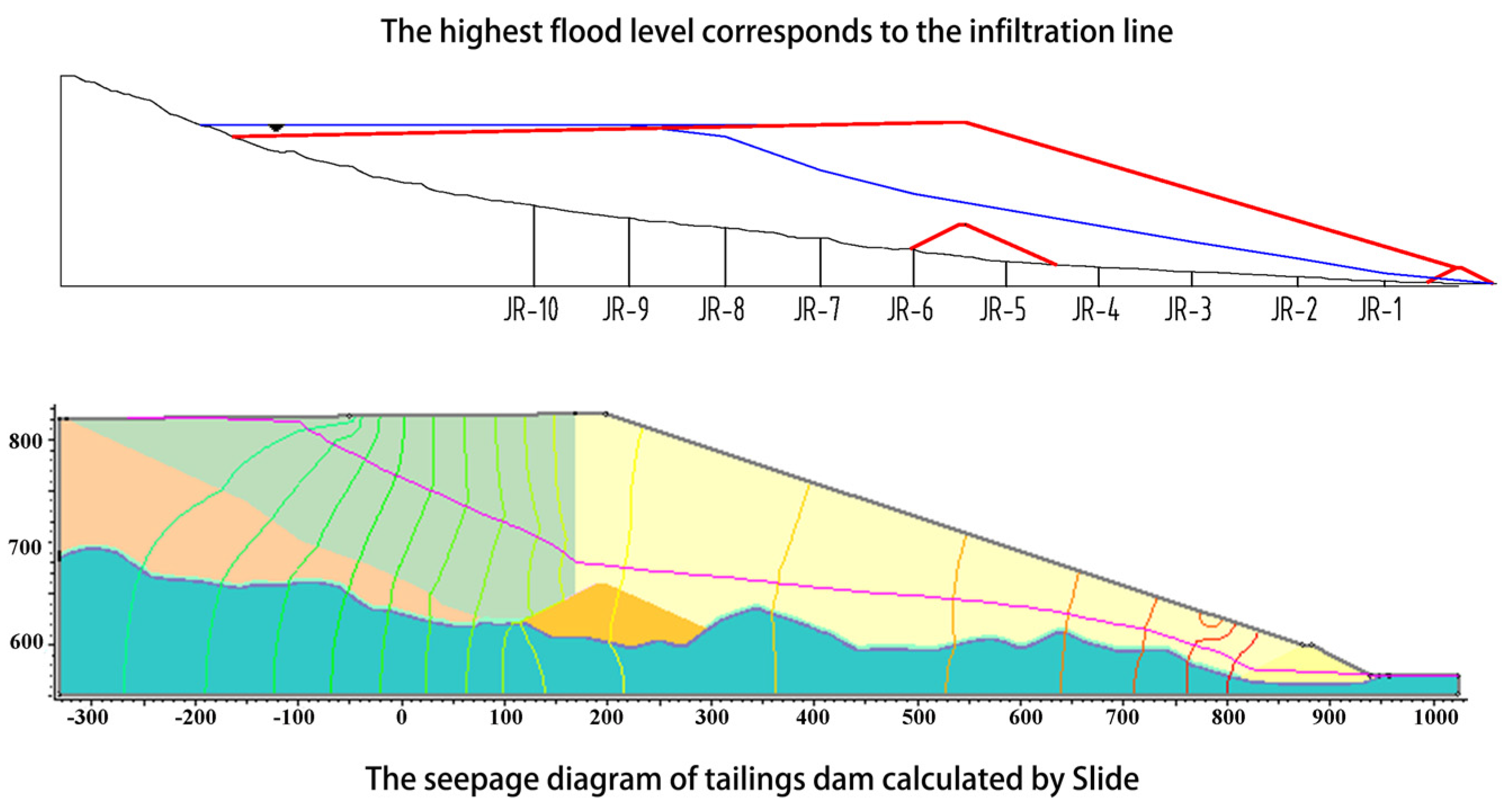
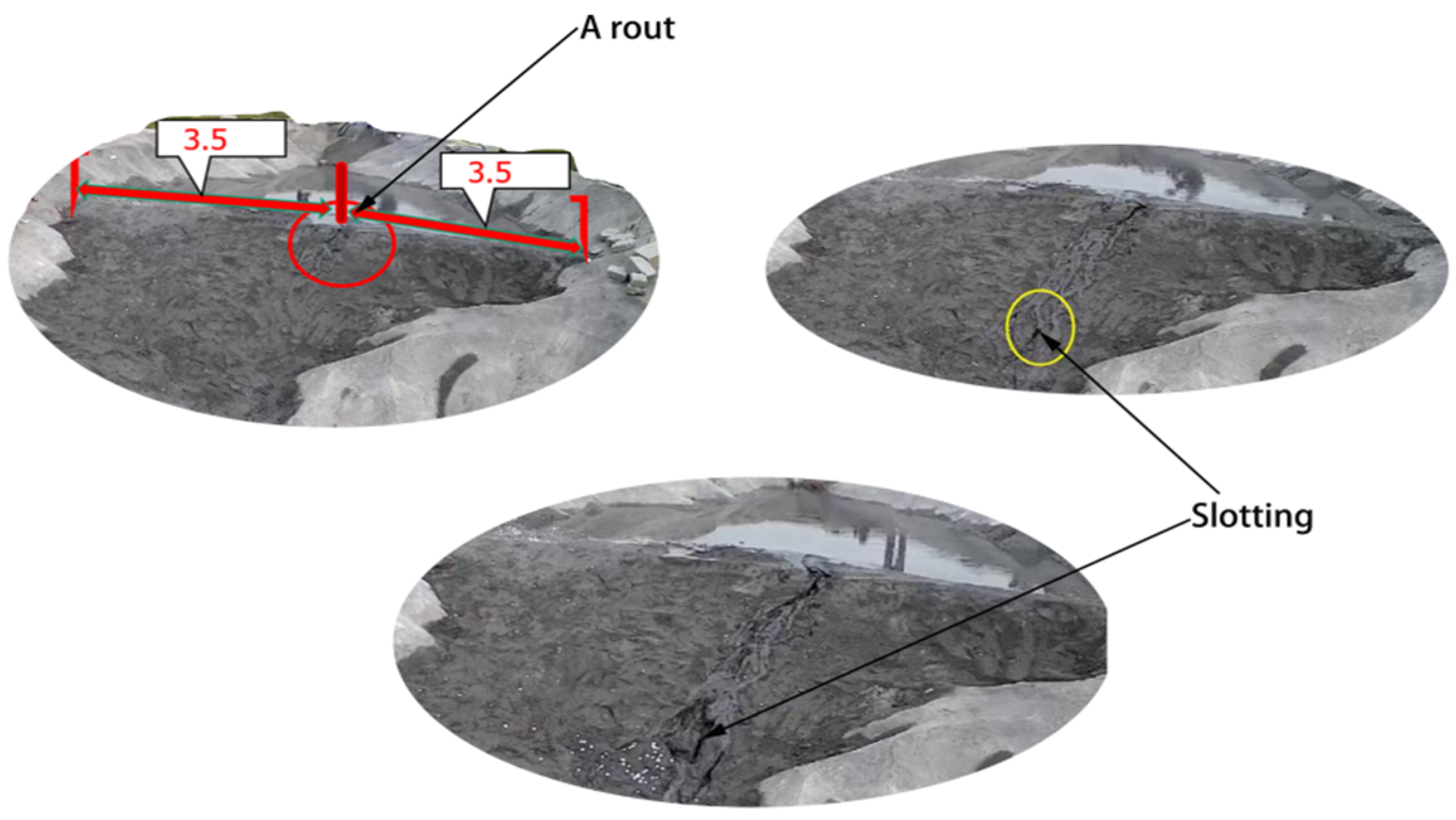
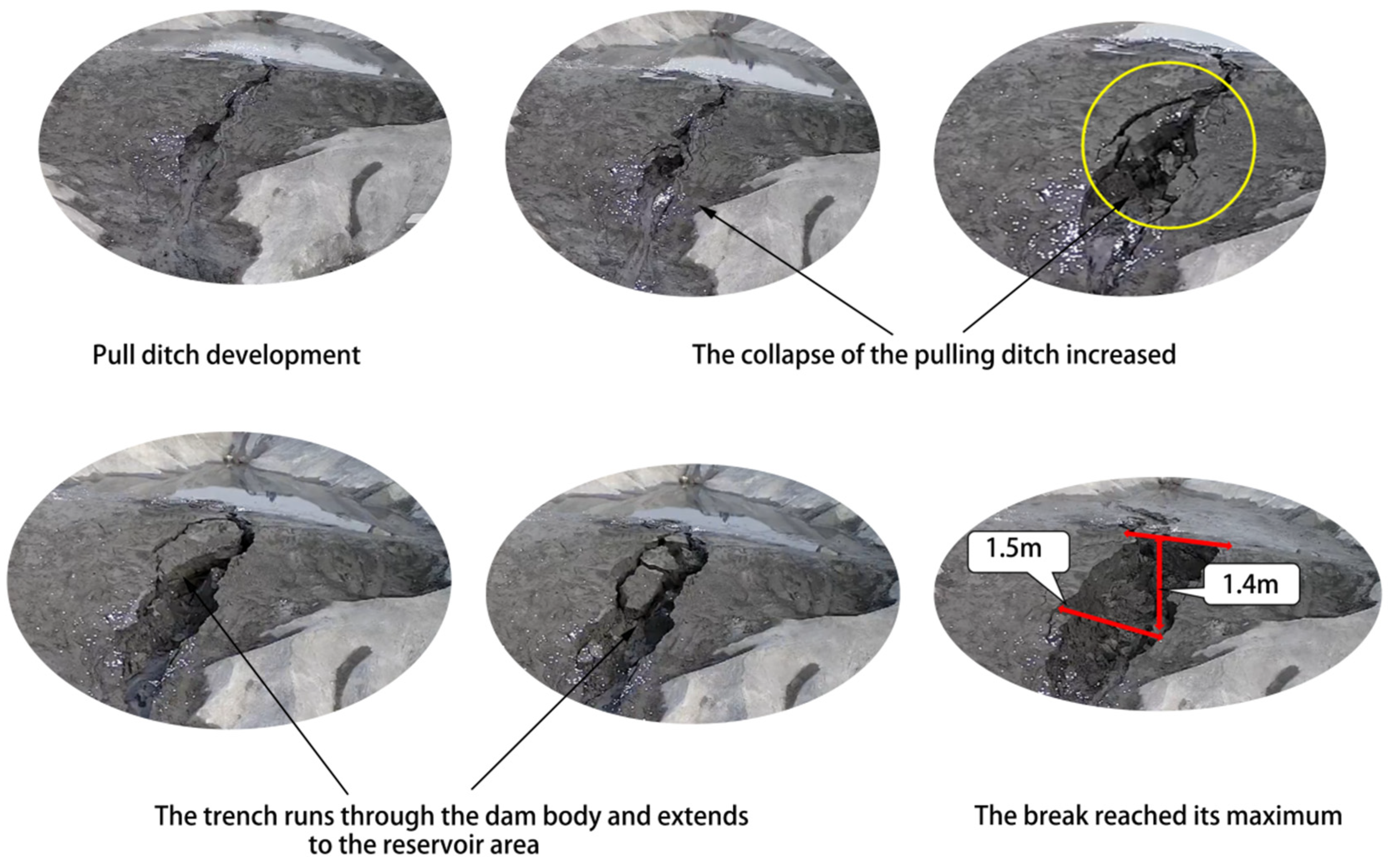
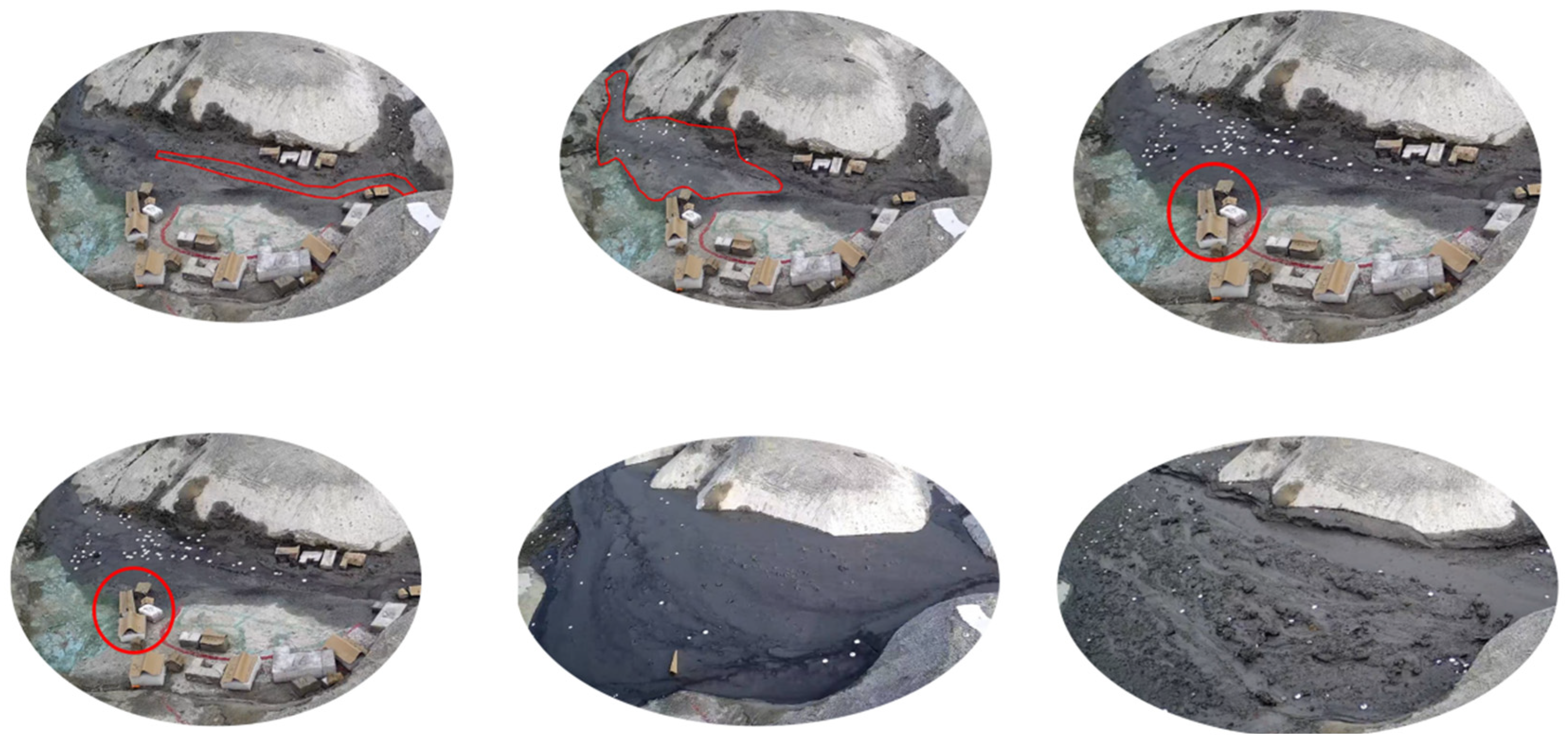
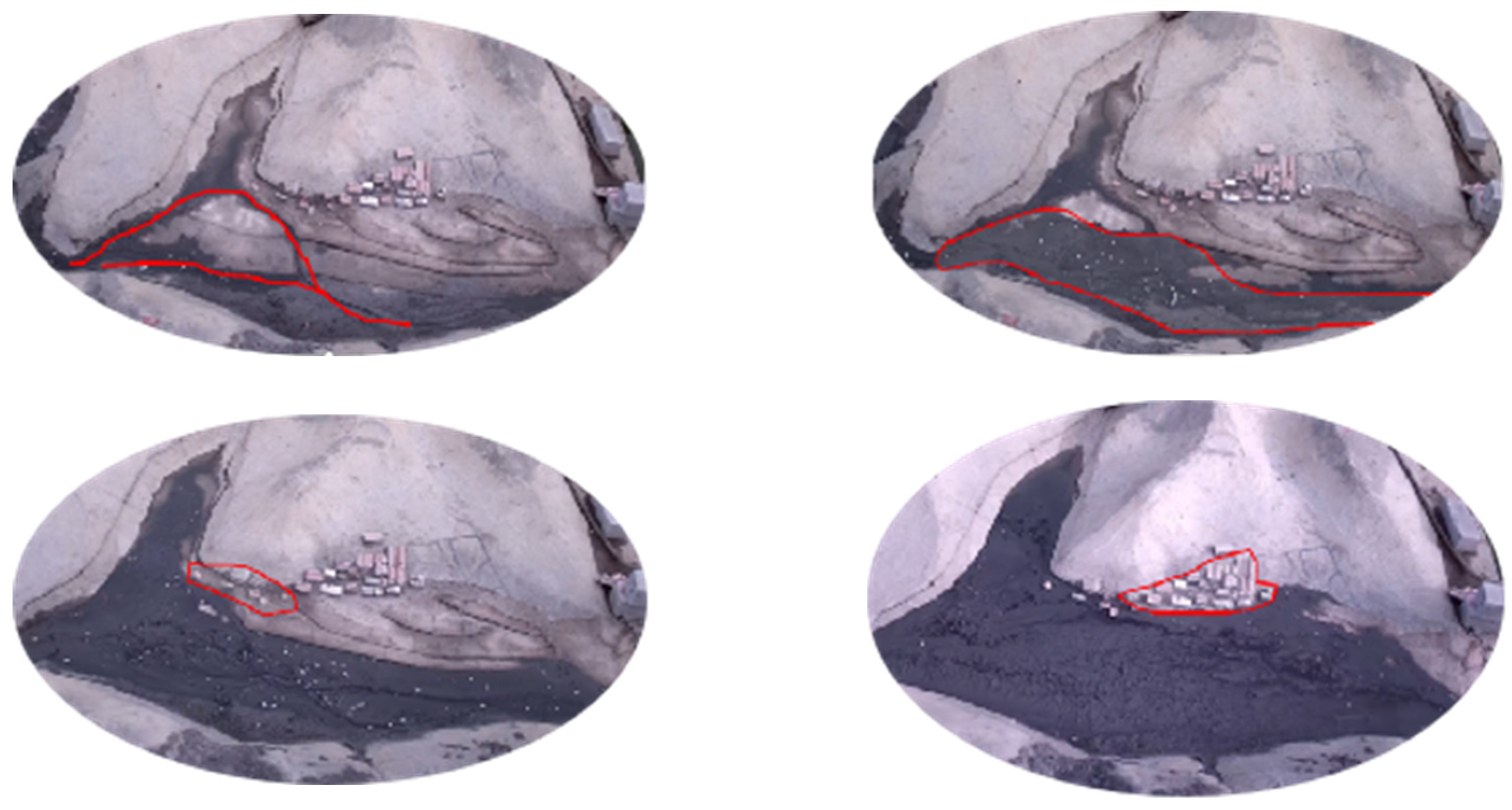


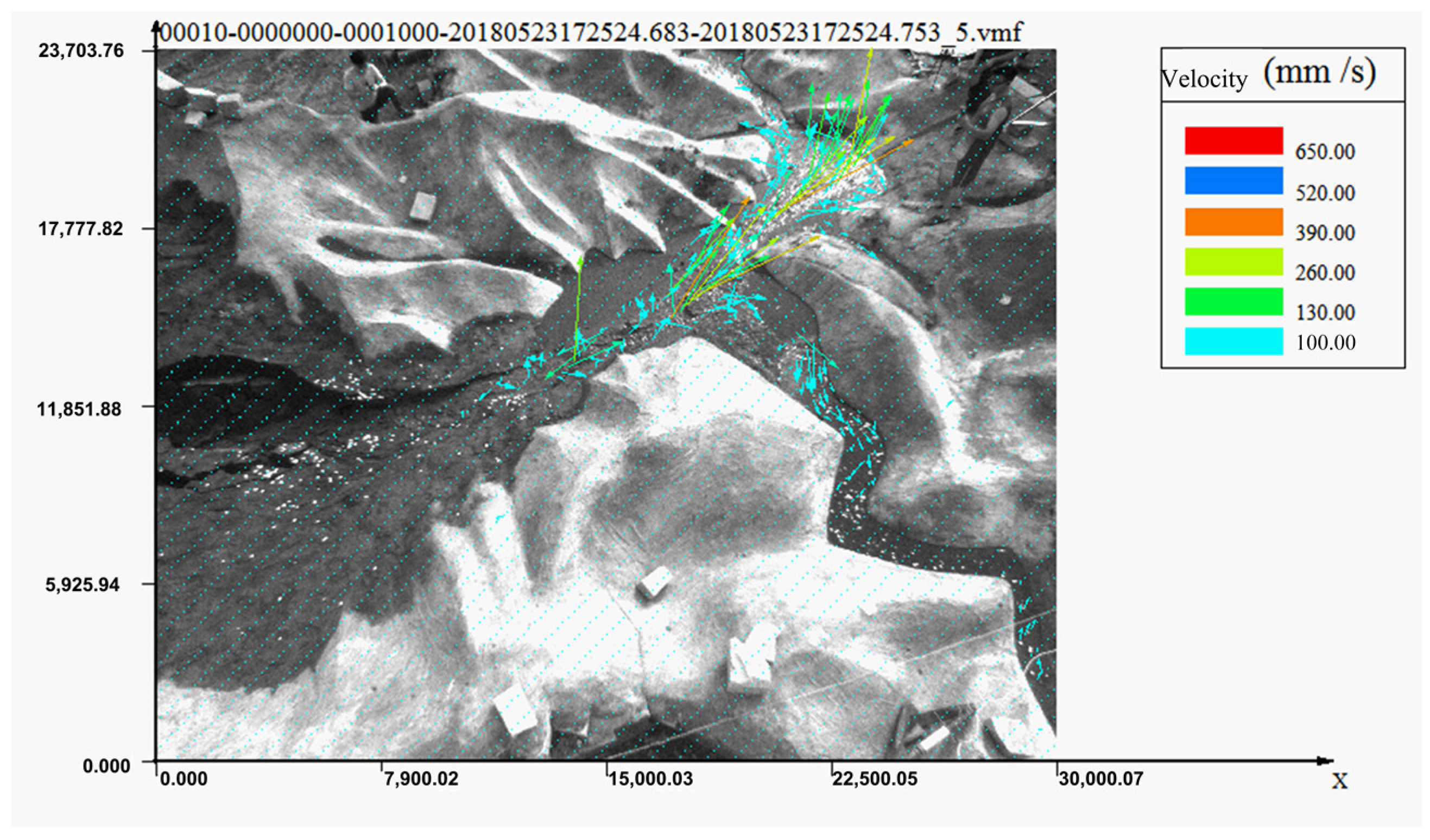
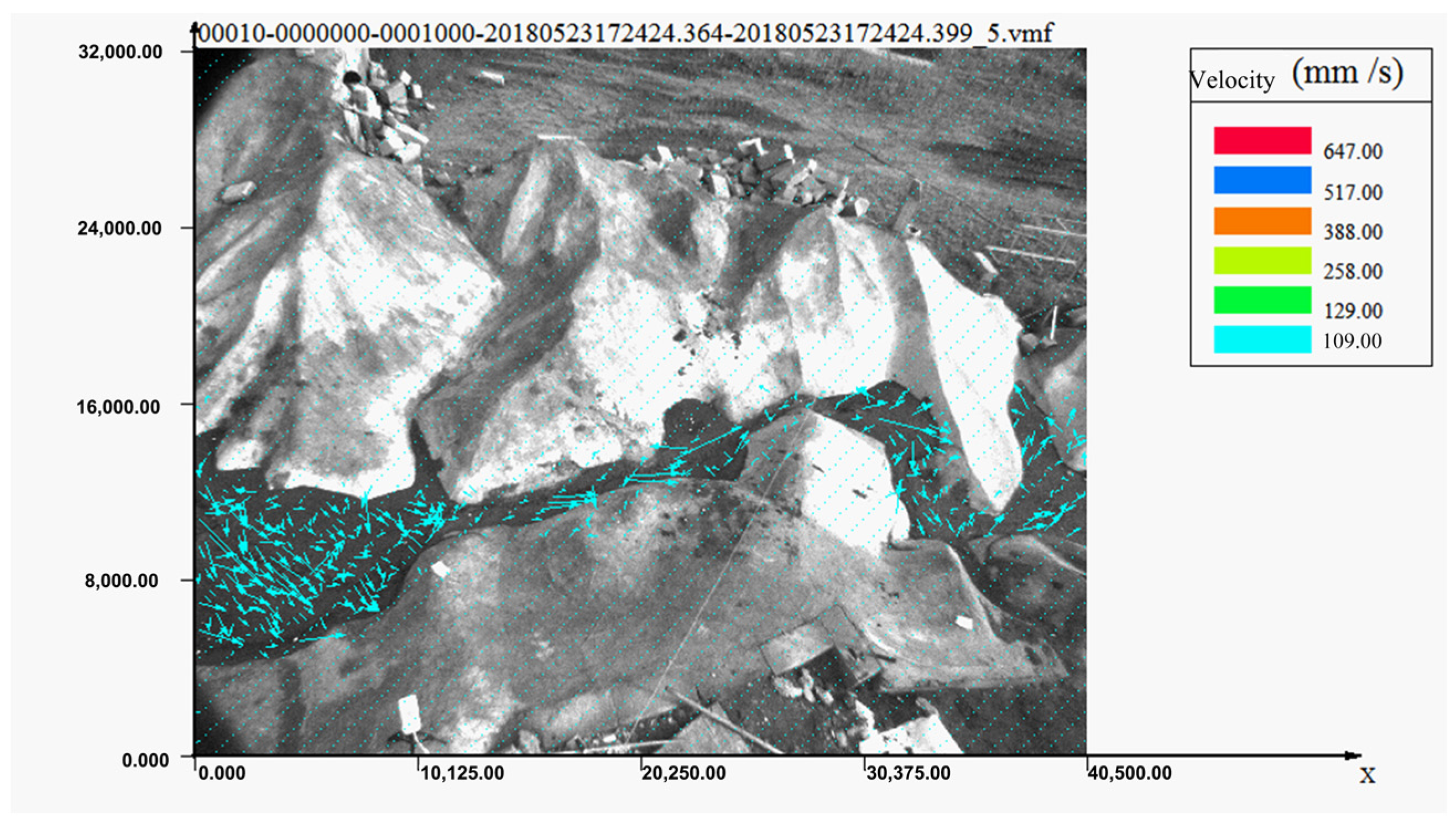
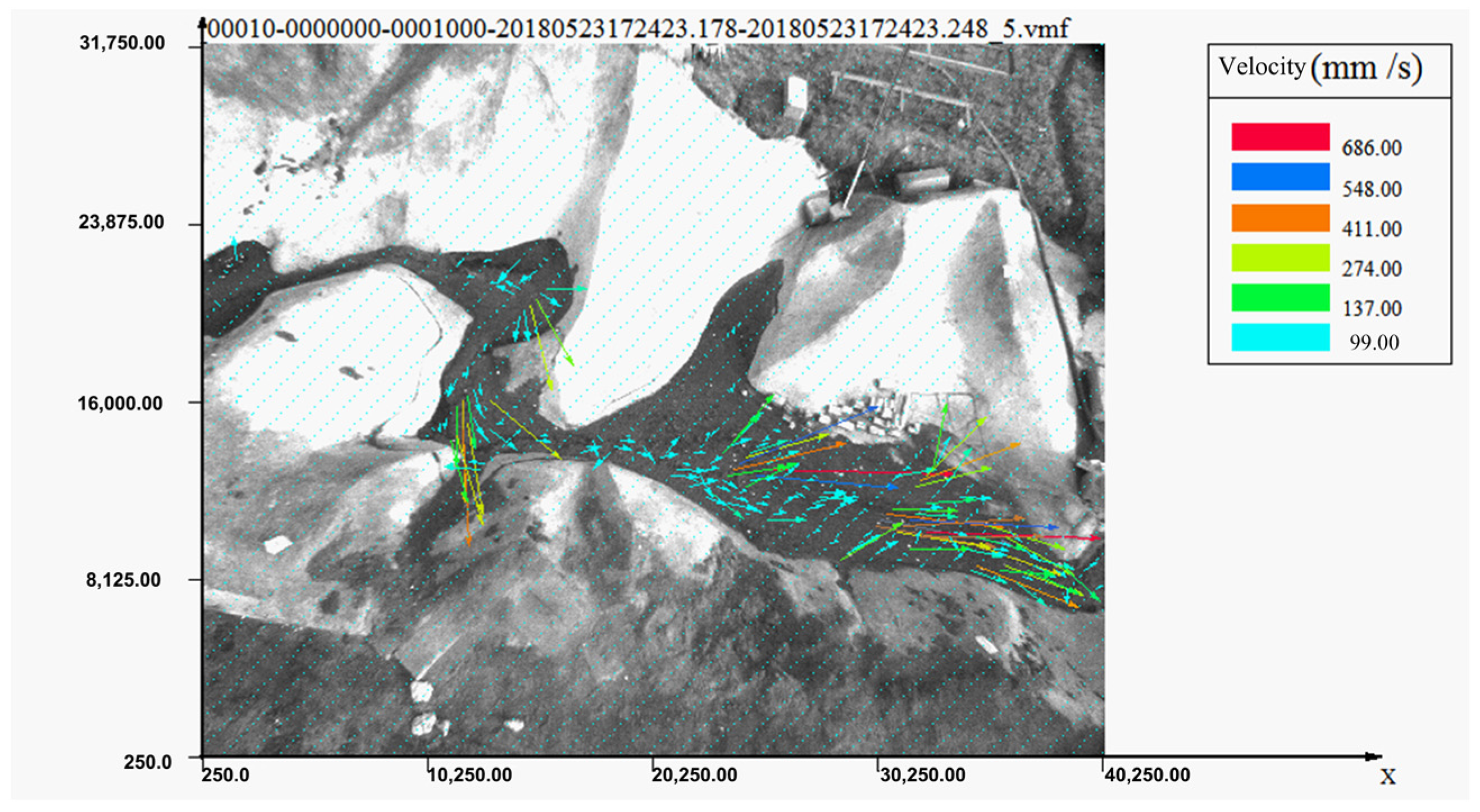
| Sand Sample | Specific Gravity Gs | Dry Density ρ/(g·cm−3) | Osmotic Coefficient K/(m·s−1) | Friction | Cohesion c/KPa |
|---|---|---|---|---|---|
| Prototype sand | 2.64 | 1.31 | 2.2 × 10−5 | 31.75 | 16.33 |
| Model sand | 2.12 | 0.96 | 4.2 × 10−5 | 31.71 | 10.70 |
| Similarity Criterion | Scale Name | Scale Symbol | Formula | Value |
|---|---|---|---|---|
| Geometric similarity | Geometric | - | 150 | |
| Similarity in water flow movement | Time | Equation (1) | 12.25 | |
| Velocity | Equation (1) | 12.25 | ||
| Flow | 275,568 | |||
| Roughness | 2.31 | |||
| Similar movement of tailings | Grain size | Equation (2) | 2.89 | |
| Dry density | 1.1 | |||
| Sand content | Equation (3) | 1.1 | ||
| Erosion and sedimentation time | Equation (4) | 12.25 |
| Category | Sand Particles | Silt | Clay Particle | |||
|---|---|---|---|---|---|---|
| Gradation | Coarse | Centre | Fine Particle | |||
| Grain Size (mm) | 2.0~0.5 | 0.5~0.25 | 0.25~0.075 | <0.075 | <0.005 | |
| Fine mud tailings | Content (%) | 1.6 | 2.1 | 18.0 | 58.8 | 19.5 |
| Gravity tailings | Content (%) | 40.3 | 39.5 | 14.3 | 2.6 | 3.3 |
| Natural Moisture Content ω (%) | Specific Gravity Gs | Dry Density ρd (g/cm3) | Saturation Density ρsat (g/cm3) | Degree of Saturation Sr (%) | Void Ratio | Liquid Limit wL (%) | Plastic Limit wp (%) | Plasticity Index Ip | Liquidity Index IL | Permeability Coefficient K (m/s) | Mechanical Indicators | |
|---|---|---|---|---|---|---|---|---|---|---|---|---|
| Friction φ (°) | Cohesion c (kPa) | |||||||||||
| 10.45 | 2.64 | 1.31 | 1.72 | 0.35 | 0.69 | 20.15 | 3.86 | 16.29 | 0.40 | 2.2 × 10−5 | 31.75 | 16.33 |
| Index | Rate of Water Content | Prototype Sand | Model Sand |
|---|---|---|---|
| Friction angle | 10% | 32.83 | 31.81 |
| 15% | 32.27 | 31.4 | |
| 20% | 33.43 | 31.93 | |
| Cohesion | 10% | 11.922 | 9.9007 |
| 15% | 12.27 | 12.27 | |
| 20% | 11.064 | 10.142 |
| Sand Particles | Silt | Clay Particle | |||
|---|---|---|---|---|---|
| Gradation | Coarse | Centre | Fine Particle | ||
| Grain size (mm) | 2.0~0.5 | 0.5~0.25 | 0.25~0.075 | <0.075 | <0.005 |
| Content (%) | 13.5 | 19.85 | 48.85 | 12.85 | 4.95 |
| Natural Moisture Content ω (%) | Specific Gravity Gs | Natural Density ρ (g/cm3) | Permeability Coefficient K (m/s) | Mechanical Indicators | |
|---|---|---|---|---|---|
| Friction φ (°) | Cohesion c (kPa) | ||||
| 41 | 2.117 | 0.96 | 4.2 × 10−5 | 31.71 | 10.7 |
| Day | JR-10 | JR-9 | JR-8 | JR-7 | JR-6 | JR-5 | JR-4 | JR-3 | JR-2 | JR-1 |
|---|---|---|---|---|---|---|---|---|---|---|
| 1 | 170 | 163 | 162 | 130 | 106 | 84 | 68 | 46 | 35 | 20 |
| 2 | 176 | 163 | 162 | 138 | 107 | 95 | 70 | 49 | 34 | 20 |
| 3 | 177 | 175 | 173 | 147 | 116 | 96 | 67 | 49 | 33 | 20 |
| 4 | 176 | 175 | 173 | 142 | 113 | 96 | 67 | 51 | 34 | 20 |
| Day | JR-10 | JR-9 | JR-8 | JR-7 | JR-6 | JR-5 | JR-4 | JR-3 | JR-2 | JR-1 |
|---|---|---|---|---|---|---|---|---|---|---|
| Day1/8:30 | 150.5 | 127.5 | 113 | 100 | 71 | 52 | 45 | 40 | 10 | 6 |
| Day1/16:56 | 130 | 106 | 95 | 101 | 70 | 42 | 44 | 40 | 10 | 6 |
| Day2/8:48 | 109 | 97 | 85 | 100 | 68 | 46 | 44 | 34 | 10 | 9 |
| Day2/14:46 | 161 | 149 | 124 | 106 | 70 | 49 | 44 | 33 | 10 | 9 |
| Day3/8:42 | 131 | 111 | 105 | 93 | 68 | 59 | 55 | 59 | 31 | 12 |
| Day3/10:15 | 137 | 124.5 | 105 | 96 | 95 | 79 | 52 | 53 | 29 | 12 |
| Day3/14:35 | 155 | 167 | 126 | 109 | 95 | 52 | 51 | 54 | 28 | 15 |
| Day3/14:41 | 174 | 173 | 147 | 125 | 95 | 78 | 61 | 59 | 28 | 15 |
| ID | Model Wetted Line Height (cm) | Corresponding Prototype Wetted Line Height (m) |
|---|---|---|
| JR-1 | 18 | 587 |
| JR-2 | 20 | 590 |
| JR-3 | 48 | 632 |
| JR-4 | 67 | 661 |
| JR-5 | 82 | 683 |
| JR-6 | 102 | 713 |
| JR-7 | 127 | 751 |
| JR-8 | 161 | 802 |
| JR-9 | 170 | 815 |
| JR-10 | 172 | 818 |
Disclaimer/Publisher’s Note: The statements, opinions and data contained in all publications are solely those of the individual author(s) and contributor(s) and not of MDPI and/or the editor(s). MDPI and/or the editor(s) disclaim responsibility for any injury to people or property resulting from any ideas, methods, instructions or products referred to in the content. |
© 2023 by the authors. Licensee MDPI, Basel, Switzerland. This article is an open access article distributed under the terms and conditions of the Creative Commons Attribution (CC BY) license (https://creativecommons.org/licenses/by/4.0/).
Share and Cite
Luo, C.; Li, D.; Xu, B. Study on the Evolution of Tailings Dam Break Disaster under Complex Environment. Sustainability 2023, 15, 14728. https://doi.org/10.3390/su152014728
Luo C, Li D, Xu B. Study on the Evolution of Tailings Dam Break Disaster under Complex Environment. Sustainability. 2023; 15(20):14728. https://doi.org/10.3390/su152014728
Chicago/Turabian StyleLuo, Changtai, Dongwei Li, and Bin Xu. 2023. "Study on the Evolution of Tailings Dam Break Disaster under Complex Environment" Sustainability 15, no. 20: 14728. https://doi.org/10.3390/su152014728





